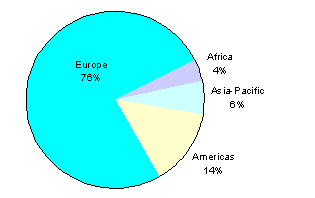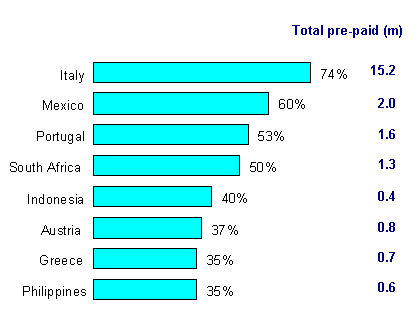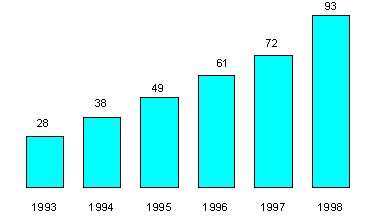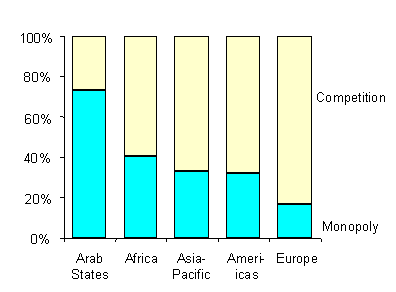World Telecommunication Day 2000
|
World Telecommunication Day 2000 |
Bright Future for Cellular Mobile
In the world of telecommunications, the closing decade of the last millennium was characterized by two phenomena which are already revolutionizing the way we work, play and go about our daily tasks: the Internet and mobile communications. The birth of the World Wide Web is now bringing the power of the Internet within reach of millions around the world, and, with the advent of new applications like online financial services, health care and electronic commerce, is accelerating the processes of globalization and fundamentally reshaping the world economic order.
Even more important, though, has been the widespread uptake of mobile telecommunications services. While Internet connectivity continues to grow fast, it’s worth noting that the market for cellular mobile is growing annually at 36% worldwide, and up to 100% or even more in some markets like China and Korea. And in terms of penetration, while the number of people connected to the Web is only around 20-25% of the population in the more wired nations, cellular mobile penetration has reached in some countries of Europe dizzying heights of more than 60%. That means that even in the world’s most affluent nations, people are more than twice as likely to have a mobile phone than an Internet connection – a probability that spirals in the developing world, where Internet connectivity is hampered by outdated wireline networks at the same time as mobile services are booming.
Several factors account for this tremendous growth in mobile services. The most obvious element is, of course, convenience. People don’t like to be wired to the network like a piece of phone equipment – instead, they’d prefer that the network find them, whenever they need to be in touch. Mobile services is starting to free workers from the tyranny of the desktop, enabling them to be more flexible, and more responsive to their customers and colleagues. At the same time, mobile helps families and friends keep in touch, regardless of busy lifestyles that increasingly keep people away from their home telephone.
But convenience is only part of the story. Other factors such as national regulation of mobile markets, the cost of network deployment, pricing and improved quality of service have all contributed to an accelerating explosion in mobile services right around the world.
Mobile for Universal Access
While consumers in wealthy countries may choose mobile telecommunications over fixed-line service for reasons of personal convenience, in the world’s developing nations mobile services are increasingly being used to help plug the gap between demand and supply. For many countries in Africa, Latin America and parts of Asia, waiting lists for telephone service have been measured not in weeks but in years, as local telephone companies struggle to maintain legacy systems, increase the number of available lines, and keep vital equipment operational in harsh economic and climatic conditions.
|
Pre-paid mobile cellular subscribers 1998 total: 40 million |
 |
|
Source: ITU |
What’s more, the lack of a national manufacturing base often means the countries with the greatest need pay much more per line to upgrade their networks than their counterparts in advanced economies, which benefit from highly competitive markets for telecoms equipment. Finally, access to traditional wireline service remains restricted in many nations for simple reasons of geography; rugged mountains, wet swampy plains or vast, parched deserts are often impossible to serve using standard copper twisted pair.
That’s where mobile steps in. With cheaper and faster network deployment, new operators can be up and running in just a few months, bringing much-needed access to towns and villages across the country, particularly in fixed wireless access which has stripped off the costly roaming component while keeping the benefits of wireless technology. What’s more, mobile can go where fixed-line can’t, meaning communities cut-off because of inaccessibility can finally gain access to vital communications services, regardless of their location.
If the Price is Right
Of course, for most developing countries, getting networks in place is only part of the story. If mobile services are priced way beyond the reach of the average user, operators will never recoup the costs of installation, let alone turn a profit.
| Prepaid
mobile cellular subscribers Top 8 countries as % of total, 1998 |
|---|
 |
|
Source: ITU. |
Likewise, in the affluent world pricing of mobile services has recently been shown to be the single most important factor governing service uptake. While demand for mobile telephony grew steadily but slowly since the beginning of the last decade, the introduction of pre-paid service in Portugal in 1995 precipitated an explosion in mobile uptake, as users happily signed up for service safe in the knowledge that mobile charges were firmly under the control of their pre-paid access card. Now, some five years on, pre-paid subscribers account for a staggering 75% of total subscribers in Italy, Europe’s largest mobile market, and for more than half the total user base in countries such as Mexico, Portugal and South Africa.
Pre-paid leaders
Distribution of pre-paid mobile cellular subscribers by region, 1998 and Top 8 countries by share of pre-paid subscribers, 1998. Source: ITU World Telecommunication Indicators Database.
Even in the realm of standard contract subscriptions, mobile pricing is becoming much more competitive, thanks to the introduction of vigorous competition in many markets around the world. In some countries, the cost of a mobile call is now on a par with the same call made over a fixed line. At the same time, changes to the regulatory environment can have a significant impact on the affordability of mobile service. In Mexico, for example, a change from a "called party pays" regime to a "calling party pays" system resulted in a huge upswing in mobile use.
| Number of countries with mobile cellular
competition 1993-98, and market structure by region, 1999 |
|---|
 |
|
Source: ITU |
In the developing world, much work still needs to be done to bring both equipment and services within an affordable range. But with more and more countries opening their markets to mobile competition and the costs involved in installing and operating a mobile network much lower than a fixed-line system, the price of mobile calls seems certain to continue to fall. For the four billion people who live in the world’s developing nations, that could be some of the best news they’ve heard in years.
A Well-Regulated Pace
One of the reasons for the rapid proliferation of cellular services is undoubtedly the mobile regulatory environment, which has differed markedly from that of its fixed-line cousin. While the PSTN continues to be tightly controlled, regulation of mobile cellular has tended to be minimal. Initially, this was because most regulators viewed mobile as a niche market, a value-added service which essentially fell outside the regulatory scope of basic voice telephony. More recently, flourishing mobile markets have led many national authorities to maintain a hands-off approach on the basis that over-regulation of fixed-line services has, in some cases, stifled network growth.
| Digital cellular service, market status by region, 1999 |
 |
|
Source: ITU |
Around the world, the number of countries allowing some level of competition in mobile services continues to grow, up from just 28 in 1993 to 103 at the beginning of this year. With all major markets around the world now liberalized, only a tiny 1% of the world’s total mobile subscriber base continues to rely on service from a monopoly supplier. And as nations continue to work to meet their obligations under the WTO agreement on Trade in Telecommunications or are preparing offers, that number will shrink away to almost nothing over the next five years – good news for customers, who can generally look forward to better service at a lower price.
For developing nations, progressive liberalization of mobile markets can provide great opportunities for improving access to communications services. With many of the world’s larger mobile operators now on the look out for untapped markets with strong growth potential, regulators can generate much-needed capital through mobile licence fees, while helping extend fixed networks to outlying regions by building network expansion obligations into those licences. Such strategies are already being used, with some success, in countries like the Philippines, where concessions to operate mobile networks in high-profit markets like Manila also stipulate the installation of networks in outlying regions which have long suffered from a lack of telecommunications access.
Another mechanism for improving access at a local level is to licence local entrepreneurs as mobile service resellers. This is already working well in Bangladesh, for example, through arrangements with Grameen Telecom, the telecommunications arm of Muhammad Yunus’s famous Grameen Bank. Under the scheme, local entrepreneurs buy a mobile handset and cellular connection from Grameen Phone, then resell capacity to villagers, who pay low per-minute charges to make and receive calls. By enabling local people to set up as community phone centres, Grameen Phone is helping promote much-needed access to telecommunications in small communities around the country, while at the same time helping families establish profitable and sustainable businesses.
Services Now and in the Future
If the 1990s was the decade of digital, the early years of the new millennium will see a spree in ‘3G’. Improvements in service quality through the advent digital systems, introduced throughout Europe around 10 years ago, were yet another important factor driving mobile uptake. Out of an estimated 450 million cellular subscribers worldwide, well over two thirds are now connected to digital networks, and that number is growing fast. Crisper voice quality, plus the ability to send and receive text-based messages over systems like Simple Message Service (SMS) and, more recently, Wireless Application Protocol (WAP) services, has greatly increased the utility of mobile handsets.
Now, the world is readying itself for a mobile data revolution as countries gear up for the introduction of so-called 3G – third generation mobile services that promise megabit data rates capable of turning the average mobile handset into a portable Web-ready computer. Some fifteen years in development under the auspices of the ITU’s Radiocommunication Sector, the global adoption of the IMT-2000 standard for third generation mobile at a meeting held in Helsinki, Finland in November last year paves the way for the launch of next-generation services in the next few years. Japan will be first to come online, with plans to launch the world’s first commercial 3G network next year. Europe and Asia will be next, with licences now being awarded and networks scheduled to begin offering services in 2002. The US, which still maintains a large analogue user base and lags the rest of the world in uptake of digital cellular technology, is due to bring up the rear sometime in 2003.
One of the great achievements of the ITU’s IMT-2000 standard is the global harmonization of mobile technology, which will mean users will at last enjoy seamless global roaming without the need to change handset, service provider and telephone number. While today’s fragmented second generation digital systems comprise a tangle of incompatible cellular and cordless standards, IMT-2000 defines a family of access methods that embrace CDMA, TDMA and FDMA systems to ensure compatibility with the many different mobile operational environments around the world.
But anywhere, anytime communications is just the beginning. For most users, the ability to roam worldwide will play second fiddle to 3G’s big advantage over second generation systems – data rates as high as 2Mbps – several times the throughput of today’s ISDN fixed lines, easily high enough to support Web
|
The tangle of 2G cellular and cordless standards |
||||
|
Americas |
Europe, Africa, |
Asia-Pacific |
||
|
Middle East |
Japan |
Others |
||
|
Analogue |
AMPS |
NMT |
JTAC |
NMT |
|
CT1 |
TACS |
TACS |
||
|
CT1 |
AMPS |
|||
|
Digital |
D-AMPS |
GSM |
PDC |
GSM |
|
PCS1900 |
DCS1800 |
CDMA |
CMDA |
|
|
CDMA |
DECT, CT2 |
PHS |
CT2 |
|
|
CT2, PWT, PACS |
||||
browsing over a mobile handset. A quick glance at the 3G handset prototypes now being shown by the world’s major manufacturers, and it’s clear that the future of mobile will soon be inextricably linked with that of the Internet itself.
And so it is that two phenomena less than 10 years old – digital cellular, and the World Wide Web – are already reshaping the lives of people around the world, in rich and poor nations alike. For the ITU, the priority of the coming decade will be to extend the global harmonization efforts embodied in the IMT-2000 standard at a regulatory level, ensuring that the huge benefits of mobile Internet are made accessible to as many people as possible. Through deft policy-making and management of national mobile markets, there’s no reason why every country in the world shouldn’t soon be enjoying the fruits of the coming mobile data revolution.n
| Newsroom Home | Search the Newsroom | Contact
the ITU Press & Public Information Service |
English | Français | Español
Created by the Press and Public Information
Service
Last Modified: 2002-04-09